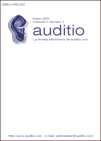Central Auditory Function
DOI:
https://doi.org/10.51445/sja.auditio.vol2.2003.0025Keywords:
Central auditory processing dissorder, dichótic tests, monothic test, binaural integration test, temporal processing, electrophysiológical testAbstract
Central Auditory Processing Disorders (CAPD) result from a deficit in sensory processing that affects listening, speech understanding, and learning. These deficits are the product of the inability or lack of ability to attend, discriminate, recognize or understand information of auditory origin. The study of central auditory functions is complex since it does not constitute a unitary entity attributable to a single nosological category. The deficits observed in the processing of auditory information at the central level can be expressed in very different ways and respond to multiple etiologies. The study of hearing as a central phenomenon implies an approach from a functional perspective that requires an approach to hearing as a process and extensive knowledge about the functional anatomical correspondences of hearing. Audiological evaluation of these disorders includes the use of psychoacoustic and electrophysiological tests selected according to the patient's medical history. The proposed interventions for patients diagnosed with CAPD are based on the use of central resources in the improvement of linguistic and cognitive abilities, development of auditory-linguistic skills, development of metalanguage, use of compensatory strategies, and development of listening and metacognition strategies.
Downloads
Visibility and Altmetrics
Metrics
Global Statistics ℹ️
|
2628
Views
|
2945
Downloads
|
|
5573
Total
|
|
References
Frumkin, N.L., Potchen, E.J., Aniskiewicz, A.S., Moore, J.B., y Cooke, P.A. (1989). Potential impact of magnetic resonance imaging on the field of communication disorders. Asha, 31, 95-99.
Faingold, C.L., Hoffmann, W.E., y Caspary, D.M. (1989). Effects of excitant amino acids on acoustic responses of inferior colliculus neurons. Hearing Research, 40,127-136. https://doi.org/10.1016/0378-5955(89)90106-8
Godfrey, D., Park, J., Dunn, J., y Ross, C. (1985). Cholinergic neurotransmission in the cochlear nucleus. In D. Frecher (Ed.). Auditory neurochemistry (pp. 163-183). Springfield, IL: Charles C. Thomas.
Guth, P., y Melamed, B. (1982). Neurotransmission in the auditory system: A primer for pharmacologist. Annual Review of Pharmacology and Toxicology, 22, 383-412. https://doi.org/10.1146/annurev.pa.22.040182.002123
Dolan, D.F., y Nuttal, A.L. (1988). Masked cochlear whole-nerve response intensity function altered byelectrical stimulation ofthe crosses olivo-cochlear bundle. Journal of the Acoustical Society of America, 83, 1081-1086. https://doi.org/10.1121/1.396052
Galambos, R. (1956). Suppresion of auditory nerve activity by stimulation of efferent fibers to cochlea. Journal of Neurophysiology, 19, 424-437. https://doi.org/10.1152/jn.1956.19.5.424
Hall, J.W. III (1992). Handbook of auditory evoked responses. Boston: Allyn & Bacon.
Hart, K.J., y Morgan, J.R. (1993). Cognitive-behavioral procedures with children: Historical context and current status. In A.J. Finch, W.M. Nelson, & E.S. Ott (eds.), Cognitive-behavioral procedures with children and adolescents (pp. 1-24). Boston: Allyn & Bacon.
Chedru, F., Bastard, V., y Efron, R. (1978). Auditory micropattern discrimination in brain damaged subjects. Neuropsychologia, 16, 141-149. https://doi.org/10.1016/0028-3932(78)90102-1
Colson, K., Robin, D., Y Luschei, E. (1991). Auditory processing and sequential pitch and timing changes following frontal opercular damage. Clinical Aphasiology, 20, 317-325.
Divenyu, P.L., y Robinson, A.J. (1989). Nonlinguistic auditory capabilities in aphasia. Brain and Language, 37, 290-326. https://doi.org/10.1016/0093-934X(89)90020-5
Grimers, A.M., Grady, C.L., Foster, N.L., Sunderland, T., y Patronas, N.J. (1985). Central auditory function inAlzheimer's disease. Neurology, 35, 352-358. https://doi.org/10.1212/WNL.35.3.352
Cranford, J., stream, R., Rye, C., y Slade, T. (1982). Detection versus discrimination of brief duration tones: Findings in patients withtemporal lobe damage. Archives of Otolaryngology, 108, 350-356. https://doi.org/10.1001/archotol.1982.00790540022007
Flexer, C., Millin, J., yBrown, L. (1990). Children with developmental disabilities: The effect of sound field amplification in word identification. Language, Speech, and Hearing Services in Schools, 21, 177-182. https://doi.org/10.1044/0161-1461.2103.177
Keith, R.W., Rudy, J., Donahue, P.A., y Katbamma, B. (1989). Comparison of SCAN results with other auditory and language measures in a clinical population. Ear & Hearing, 10(6), 382-386. https://doi.org/10.1097/00003446-198912000-00011
Robin, D.A., Tomblin, J.B., Kearney, A., y Hugg, L.N. (1989). Auditory temporal pattern learning in children with speech and language impairments. Brain & Language, 36(4), 604-613. https://doi.org/10.1016/0093-934X(89)90089-8
Galaburda, A.M. (1989). Ordinary and extraordinary brain development: Anatomical variation in developmental dyslexia. Annals of Dyslexia, 39, 67-80. https://doi.org/10.1007/BF02656901
Ferre, J.M., y Wilber, L.A. (1986). Normal and learning disabled children's central auditory processing skills: An experimental test battery. Ear and Hearing, 7, 336-343. https://doi.org/10.1097/00003446-198610000-00009
Cook, J.R., Mausbach, T., Burd, L., Gascon, G.G., Slotnick, H.B., Patterson, B., Johnson, R.D., Hankey, B., y Reynolds, B.W. (1993). A preliminary study ofthe relationship between central auditory processing disorder and attention deficit dissorder. Journal of Psychiatry and Neuroscience, 18, (3), 130137.
Pillsbury, H.C., Grose, J.H., y Hall, J.W. (1991). Otitis media with effusion in children: Binaural hearing before and after corrective surgery. Archives of Otolaeyngology-Head and Neck Surgery, 117, 718-723. https://doi.org/10.1001/archotol.1991.01870190030008
Gulya, J. (1991). Structural and physiological changes of the auditory and vestibular mechanisms with aging. In D. Ripich (Ed.), Handbook of geriatric communication disorders (pp.39-54). Austin, TX: Pro-Ed.
American Speech-Language-Hearing Association Task Force on Central Auditory Processing Consensus development. (1996). Central auditory processing: Current status of research and implications for clinical practice. American Journal of Audiology, 5(2), 41-54. https://doi.org/10.1044/1059-0889.0502.41
Phillips, D.P. (1993). Representation of acoustic evets in the primary auditory cortex. Journal of Experimental Psychology: Human Perception and Preformance, 19, 203-216. https://doi.org/10.1037/0096-1523.19.1.203
Phillips, D.P. (1995). Central auditory processing: A view from auditory neoroscience. The American Journal of Otology, 16(3), 338-352.
Musiek, F.E., Baran, J.A., y Pinheiro, M.L. (1990). Duration pattern recognition in normal subjects and patients with cerebral and cochlear lesions. Audiology, 29, 304-313.
https://doi.org/10.3109/00206099009072861
Speaks, C.K., Niccum, N., y Van Tasell, D. (1985). Effects of stimulus material on dichotic listening performance on patients with sensorineural hearing loss. Journal of Speech and Hearing Research, 28, 16-25. https://doi.org/10.1044/jshr.2801.16
Divenyi, P.L., y Robinson, A.J. (1989). Nonlinguistic auditory capabilities in aphasia. Brain and Language, 37, 290-326. https://doi.org/10.1016/0093-934X(89)90020-5
Levine, R., Gardener, J., Stufflebeam,S., Fullterton, B., Carlise, E.,Furst, N., Rosen, B., y Kiang, M. (1993). Effects of multiple sclerosis brainstem lesions on sound lateralization and brainstem auditory evoked potentials. Hearing Research, 68, 73-88. https://doi.org/10.1016/0378-5955(93)90066-A
Musiek, F., Weider, D., y Muller, R. (1982). Audiological findings in Charcot-Marie-Tooth disease. Archives of Otolaryngology, 108, 595-599. https://doi.org/10.1001/archotol.1982.00790570061015
Grimes, A.M., Grady, C.L., Foster, N.L., Sunderland, T., y Patronas, N.J. (1985), Central auditory function in Alzheimer's disease. Neurology, 35, 352-358. https://doi.org/10.1212/WNL.35.3.352
Lynn, G.E., Cullis, P., y Gilroy, J. (1983). Olivopontocerebellar degeneration: Effects of auditory brainstem responses. Seminars in Hearing, 4, 375-384. https://doi.org/10.1055/s-0028-1094199
Chiappa, K. (1983). Evoked potentials in clinical medicine. New York: Cambridge University Press.
Musiek, F.E., y Baran, J.A. (1997). Central auditory assessment: Thirty years of change and challenge. Ear and Hearing, 8 (Suppl.), 22-35. https://doi.org/10.1097/00003446-198708001-00007
Jerger, J., Silman, S., Lew, H., yChmiel, R. (1993). Case studies in binaural interference: converging evidence from behavioral and electrophysiological measures. Journal of the American Academy of Audiology, 4, 122-131.
Chermak, G.D. (1981). Handbook ofaudiological rehabilitation. Springfield, IL: Charles C. Thomas.
Danks, J.H., y End, L.J. (1987). Processing strategies for reading and listening. In R. Horowitz & S.J. Samuels (Eds.), Comprehending oral and written language (pp. 271-294). San Diego, CA: Academic Press.
Fant, G. (1967). Auditory patterns of speech. In W. Wathen-Dunn (Ed.), Models for the perception of speech and visual form (pp. 111-125). Cambridge, MA:MIT Press.
Kintsch, W. (1977). On comprehending stories. In M.A. Just & P.A. Carpenter (eds.). Cognitive processes in comprehension (pp. 33-62). Hillsdale, NJ: Lawrence Erlbaum.
Massaro, D.W. (1975). Language and information processing. In D.W. Massaro (Ed.), Understanding language: An information-processing analysis of speech perception, reading and psycholinguistics. New York: Academic Press. https://doi.org/10.1016/B978-0-12-478350-8.50006-4
Keith, R.W. (1994). ACPT: Auditory continuous performance test. San Antonio, TX: Psychological Corporation. https://doi.org/10.1037/t14966-000
Abel, S.M. (1972): Discrimination of temporal gaps. Journal of the Acoustical Society of America, 52, 519-524. https://doi.org/10.1121/1.1913139
Moore, B.C.J. (1973). Frequency difference limens for short-duration tones. Journal of the Acoustic Society of America, 54, 610-619. https://doi.org/10.1121/1.1913640
Yost, W.A. y Moore, M.J. (1987). Temporal changes in a complex spectral profile. Journal of the Acoustical Society of America, 81, 1896-1905. https://doi.org/10.1121/1.394754
Musiek, F.E., Pinheiro, M.L., y Wilson, D. (1980). Auditory pattern perception in split-brain patients. Archives of otolaryngology, 106, 610-612. https://doi.org/10.1001/archotol.1980.00790340018004
Flavell, J.H. (1981). Cognitive monitoring. In W.P. Dickson (Ed.Children's oral communication skilss (pp. 35-60). New York: Academic Press.
Flavell, J.H., y Wellman, H.M. (1977). Metamemory. In R.V. ail & J.W. Hagan (Eds.), Perspectives on the development of memory and cognition (pp. 3-33): Hillsdale, NJ: Lawrence Erblbaum.
Van Dijk, T.A. (1985). Semantic discourse analysis. In T.A. Van Dijk (Ed.), Handbook of discourse analysis. Vol. 2: Dimensions of discourse (pp. 4-85). New York: Springer.
Pressley, M. (1982). Elaboration and memory development. Child development, 53, 296-309. https://doi.org/10.2307/1128972
Stach, B.A., Loiselle, L.H., yJerger, J.F. (1987), Clinical eperience with personal FM assistive listening devices. Hearing Journal, 40, 24-30.
Stach, B.A., Loiselle, L.H., y Jerger, J.F. (1991). Special hearing aid considerations in elderly patients with auditory processing disorders. Ear & Hearing, 12(6, Suppl.), 131S-138S. https://doi.org/10.1097/00003446-199112001-00007
Crandell, C. y Smaldino, J. (1995). The importance of room acoustic. In R.S. Tyler & D.J. Schum (Eds.), Assistive devices forpersonas with hearing impairment (pp. 142-164). Boston: Allyn and Bacon.
Liberman, A.M., Cooper, F.S., Shankweiler, D., y Studder-Kennedy, M. (1967). Perception of the speech code. Psychological review, 74, 431-461. https://doi.org/10.1037/h0020279
Mann, V. (1991). Language problems: A key to early reading problems. In B.Y.L. Wong (Ed.). Learning about learning disabilities (pp. 130-162). San diego: Academic Press. https://doi.org/10.1016/B978-0-12-762530-0.50011-4
Mattingly, I.G. (1972). Reading, the linguistic process, and linguistic awarness. In J.F. Kavanaugh & I.G. Mattingly (eds.), Language by ear and by eye. The relationship between speech and reading pp. 133-148. Cambridge: MIT Press.
Perfetti, C.A., y McCutchen, D., (1982). Speech processes in reading. Speech and Language Advances in Basic Research and Practice, /, 237-269. https://doi.org/10.1016/B978-0-12-608607-2.50014-5

Downloads
Published
Versions
- 2021-09-15 (2)
- 2003-11-01 (1)
How to Cite
Issue
Section
License
Copyright (c) 2003 Auditio

This work is licensed under a Creative Commons Attribution 3.0 Unported License.
All articles will be published under the open Creative Commons Attribution (CC-BY) license. This license allows others to share and adapt the content, even for commercial purposes, as long as appropriate credit is given to the authors and the journal. By submitting their manuscript, authors retain copyright but grant the journal the right to make the first publication under this license.
More information about this license is available at: https://creativecommons.org/licenses/by/4.0/
Articles published between 2001 and 2020
The texts published in this journal in the section "AUDITIO 2001-2020" are subject - unless otherwise indicated - to a Creative Commons Attribution 3.0 Spain license. You can copy, distribute, communicate them publicly, make derivative works and commercial uses provided that you acknowledge the credits of the works (authorship, name of the journal, publishing institution) in the manner specified by the authors or by the journal. The full license can be consulted at http://creativecommons.org/licenses/by/3.0/es/deed.es.









